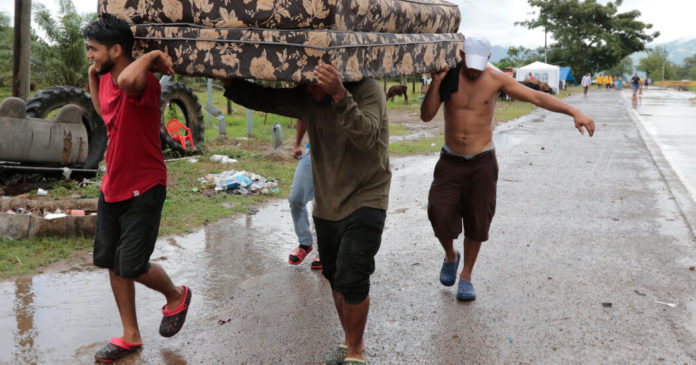Stretches of Central America braced for heavy rain, strong wind and flooding on Tuesday morning as Hurricane Iota bore down on the region, the latest hurricane to strike the area in less than two weeks. Even as Iota weakened after making landfall overnight, the National Hurricane Center warned that it could have an outsized impact as it batters areas still recovering from being hit by Hurricane Eta this month.
Iota made landfall in northeastern Nicaragua at 10:40 p.m. Eastern time on Monday as a Category 4 storm, with wind speeds of up to about 155 miles per hour, according to the National Hurricane Center in Miami. With waters rising in the northeastern Nicaraguan city of Puerto Cabezas, hundreds of families evacuated from coastal communities as the storm ripped roofs from homes and hotels.
By early Tuesday, Iota’s maximum wind speed had decreased to 105 miles an hour and the storm had weakened to a Category 2 hurricane, although the hurricane center described it as still “extremely dangerous.” Even as the storm was expected to weaken further as it makes its way across Nicaragua, the hurricane center warned of “life-threatening storm surge, catastrophic winds, flash flooding and landslides” across parts of Central America.
Aid workers are struggling to reach communities that were cut off by washed-out bridges, downed trees and flooded roads from Hurricane Eta, which made landfall this month about 15 miles from where Iota struck.
“Flooding and mudslides across portions of Honduras, Nicaragua and Guatemala could be exacerbated by Hurricane Eta’s recent effects there, resulting in significant to potentially catastrophic impacts,” the hurricane center said in an early morning advisory.
Iota was expected to move inland across Nicaragua during the morning and across southern Honduras by the evening. On Tuesday morning, the storm’s eye was about 40 miles southwest of Puerto Cabezas.
Philip Klotzbach, a research scientist at Colorado State University, said on Twitter that Iota was the strongest November hurricane on record to make landfall in Nicaragua.
Even before Iota made landfall, its winds blew the roof off a makeshift hospital in Puerto Cabezas that had been set up to treat people affected by Hurricane Eta. Much of the city has been without power since 3 p.m. on Monday.
Iota, which became a hurricane on Sunday, is expected to produce up to 30 inches of rain in some areas of Nicaragua and Honduras through Friday. It is also expected to raise water levels “as much as 15 to 20 feet above normal tide levels” along the coasts of both countries, the hurricane center said.
Dozens of Indigenous communities were evacuated throughout the weekend in Nicaragua and Honduras, where the military shared pictures on Twitter of soldiers helping people out of stilted wooden homes and carrying them to safety. One soldier stood in knee-deep water, holding a resident’s pink backpack in the same arm as his service weapon.
The storm is hitting a region still reeling from Hurricane Eta.
Forecasters have warned that Hurricane Iota could compound the destruction caused by Hurricane Eta, which killed at least 140 people throughout Central America after making landfall as a Category 4 storm in Nicaragua.
In Puerto Cabezas, a Nicaraguan city where houses are cobbled together by wood, nails and zinc sheets, families have been sleeping amid the rubble left from the earlier storm. As waters rose on Monday evening, hundreds of families were evacuated. On the eastern side of the city, high winds blew the roofs off some structures.
One resident, Maria Williams, 64, said that after Eta reduced her modest home to rubble, her children improvised a shelter in the same spot. But it was practically on the beach and directly in Hurricane Iota’s line of fire. So she evacuated again, walking through debris left by the last storm to reach her sister’s home.
“This Hurricane Iota is a monster,” Ms. Williams said. “I no longer think I can survive if I stay in this house. I am afraid for myself and my grandchildren.”
Another resident, Rodolfo Altunes, said that he had planned to stay put while Iota hit, but that he and his wife had decided on Monday night to evacuate, with their children in tow, because the wind and storm surges were so powerful.
Two hours after leaving, he learned that his home had been destroyed.
“I am fortunate,” he said. “God loved me.”
Iota leaves flooding behind in Colombia.
Before sweeping into Nicaragua, Hurricane Iota clipped two Colombian islands that lie east of Central America’s coastline.
Photos taken on the islands, San Andrés and Providencia, showed trees bending under fierce winds. Colombian officials and news reports said that both islands had suffered electricity blackouts.
President Iván Duque said on Monday that communication with Providencia had been “very bad” because of failures in the telecommunications network, and that the Colombian military was among the agencies helping with the relief effort.
Video footage from Cartagena, a city on the country’s Caribbean coast, showed people wading cautiously through flooded streets alongside half-submerged boats.
Speaking from Cartagena, Mr. Duque said that relief workers would set off for Providencia on Tuesday if conditions allowed, and that rescue personnel planned to distribute 15 tons of humanitarian aid to the archipelago that includes San Andrés and Providencia.
“We’re here with a committed team of brave and patriotic Colombians who are working to deal with this emergency,” Mr. Duque said, flanked by relief workers in surgical masks and matching jackets.
As of Tuesday morning, a tropical storm warning was in effect for both islands.
As Iota moves inland, communities scramble to prepare.
Iota is expected to produce up to 30 inches of rain in some areas of Nicaragua and Honduras through Friday, and intense rainfall could lead to significant flash flooding and mudslides in higher elevations.
The storm is also expected to raise water levels in some places by as much as 15 to 20 feet above normal levels, and large destructive waves are expected to accompany the surge. As the storm moved west on Tuesday, patches of both nations’ coastlines were under hurricane or tropical storm warnings.
Dozens of Indigenous communities were evacuated throughout the weekend in Nicaragua and Honduras.
President Juan Orlando Hernández of Honduras said on Monday that soldiers were among many personnel in the country, including firefighters and police officers, who had been activated to prepare for Iota’s arrival. He added that people in the storm’s path would receive cellphone messages advising them of risks and evacuation plans.
“The first and most important thing is to save lives,” he said.
The most active hurricane season on record is not over yet.
The 2020 Atlantic hurricane season, which is set to end on Nov. 30, has had 30 named storms, 13 of them hurricanes. And six of those hurricanes were considered “major”— Eta and Iota among them — meaning Category 3 or higher.
Meteorologists, having exhausted the 21-name list prepared for each hurricane season, turned to the Greek alphabet to name the further new systems. The last time the Greek alphabet was used was in 2005, when 28 storms were strong enough to be named.
This year, storms began two weeks before the Atlantic hurricane season officially kicked off, with the formation of Tropical Storm Albert in mid-May.
In August, midway through the season, scientists upgraded their outlook to say that 2020 would be “one of the most active seasons” and that they expected up to 25 named storms by the time it was over.
By November, even that upgraded expectation was exceeded.
Before Iota hit Nicaragua on Monday, there was Theta, the season’s 29th named storm. It broke the annual record set in 2005, the year that Hurricane Katrina hit the Gulf Coast.
Reporting was contributed by Alfonso Flores Bermúdez, Johnny Diaz, Natalie Kitroeff, Oscar Lopez, Derrick Bryson Taylor, Neil Vigdor, Allyson Waller, Mike Ives and Megan Specia.
Source : Nytimes












